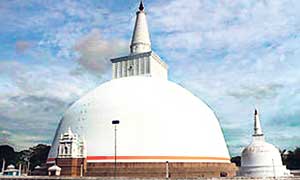Suriya Mal competes with the poppy
On a day like today
70 years ago (November 11, 1937), a call was made to everyone to support the Suriya Mal movement born in opposition to the sale of poppies to collect funds to support activities related to the welfare of ex-servicemen. This was after our own ex-service who were also involved in this collection found that the money they collected was utilized not for their welfare but the welfare of the foreign ex-servicemen. They then gradually began to move away from the sale of poppies.
The call to wear the 'suriya mal' in place of the poppy was made through a statement issued by Terence de Silva, Joint Secretary of the Suriya Mal Association. It had been formed in 1933, at a meeting in Horana at the residence of Wilmot A. Perera, founder of Sri Palee Vidyalaya and a progressive leader. A committee had been formed to run the affairs of the organization.
Miss Doreen Young, who later married Dr. S. A. Wickremasinghe (leader of the Communist Party) was elected as the President. She was the principal of Ananda Balika Vidyalaya, Maradana.
Terence N. de Silva and Robin Ratnam were elected joint Secretaries and Roy de Mel was elected Treasurer.
Initially, the funds collected by the Suriya Mal organization was used to fund the education of students selected from deprived backgrounds and for the publication of pamphlets.
The Suriya Mal Association and the Colombo Youth leagues shared the major part of the work involved with the relief work following the malaria epidemic in 1934. Small groups of men and women, mainly from western backgrounds trudged from house to house in the Thun Korale where the conditions were very bad. There were many deaths due to lack of food and nourishment. The teams of volunteers visited the sick with medicines and food items. The teachers of Ananda Balika along with their friends attended to the making of 'suriya mal.' |
Ruvanveli Seya pinnacle is laid
 |
| Ruvanveli Seya during restoration work. |
The laying of the pinnacle of the Ruvanveli Maha Seya in Anuradhapura was an event of great significance to the Buddhists in
Sri Lanka. This happened on November 11, 1939 with Sir Baron (D. B.) Jayatilaka, Buddhist leader, Leader of the House (State Council) & Minister of Home Affairs, and Diyawadana Nilame T. B. Ratwatte participating in the ceremony.
Originally built by King Dutugemunu in the 2nd century B.C., the Maha Seya was partially destroyed by Tamil invaders in the latter part of the Anuradhapura kingdom. Restoration work was started in the latter part of the 19th century by Naranvita Sumanasara Thera who obtained support from the Buddhist community as well as Governor Sir William Gregory who was deeply interested in the arts. He wrote that he contributed to the restoration work "not looking at it as a religious work but as the conservation of a great national monument." He described the Ruvanveli Seya as, "the best result of Sinhalese art identified with one of the most powerful and enlightened Kings who ever ruled this country."
|
A great writer
An outstanding figure in the literary field, Dr. Gunadasa Amarasekera's birthday falls on November 12. Hailing from Yatalamatta near Galle in 1929, son of an ayurvedia physician and a school teacher, he had his secondary education at Nalanda Vidyalaya, Colombo and later graduated in dentistry from the University of Ceylon, Peradeniya.
Winning the first place for his story 'Soma' at an international short story competition as a student at Nalanda, he continued his writing while at Peradeniya. He has written a large number of books covering a wide range – short stories, novels, poems, essays and criticism. Starting his literary career in the early 1950s with a collection of short stories 'Rathu Rosa Mala' in 1953, he created a sensation with the novel 'Karumakkarayo' (1955) breaking new ground by handling a theme on sexual relations – a theme which was considered taboo at the time. (Tissa Abeysekera made a film in 1980).
His later works include:
Novels:
'Yali Upannemi,'
'Depa Nollado,' 'Gandabba Apadanaya,' 'Asathya Kathawak,' 'Premaye Sathya Kathawa,' 'Gamanaka Mula,'
'Gamdoren Eliyata,'
'Vankagiriyaka'and 'Yali Maga Vetha'
Short Stories: 'Bhava Gita,'
'Jeevana Suwanda,' 'Amal Bisso,' 'Ekama Katava,' 'Ekatamen Polawata*,' 'Katha Pahak,' Gal Pilimaya saha Bol Pilimaya' and 'Marana Manchakaye Dutu Sihinaya' Poems: 'Uyanaka Hinga Liyu Kavi,' 'Amal Biso,' 'Gurulu Watha*,' 'Awanjana*,' 'Asak Da Kava'
Literary and Social Issues: 'Abuddasasa Yugayak,' 'Anagarika Dharmapala Marxvaadida?,' 'Ganaduru Madiyama Dakinemi Arunalu,' 'Arunaluseren Arunodhyata,' 'Jathika Chinthanaya saha Jathika Aarthikaya' and ‘Sinhala Kavya Sampradaya.'
* Won State Literary Award
|


